January 2019 was very much a month of two halves weather-wise in this area - The first half was unseasonably mild and often more like autumn or spring than winter, with no extreme conditions, and temperatures often up in high single figures.. however....winter bit back with a vengeance in the second half, with plenty of snow and frosts, and temperatures down to -12c which was much more typical of January up here.
By being flexible, and cherry-picking the best days weather-wise, we had some really enjoyable adventures out 'in the wilds', with the excellent off-road and winter weather abilities and interior comforts of my Land Rover Discovery often proving to be a necessity rather than a luxury!
On a positive note, the days are lengthening noticeably now, with over 8 hours of usable daylight, and dawn (for the Black Grouse) is still a relatively sociable 7:30am.
Full-day local safari bird lists usually topped-out in the 40's, though a trip to the nearby Moray Coast can boost this total considerably, whilst mammal day lists varied between 4 and 8 depending on the time of our start and number of habitats visited, with early starts usually proving to be best.
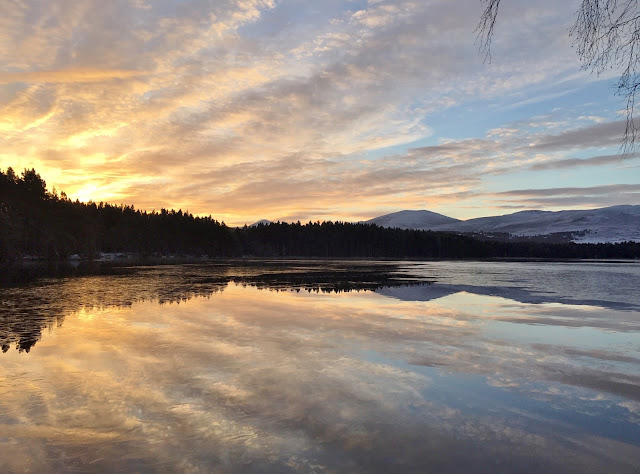 |
| Sunrise at a beautiful local loch |
To give you an idea of what you may realistically hope to see if you are planning a future
January visit yourself, I hope the following more detailed information, illustrated with photos taken in and around the Cairngorms National Park and nearby Moray coast, by myself , my friends or my safari clients will help - clicking on the picture will enlarge it to full screen.
Wildlife highlights:
Local speciality/upland bird species seen regularly during the month included:
Black Grouse (at dawn only),
Red Grouse,
Crested Tit,
Dipper , Goldeneye, and
Golden Eagle... We also had a few decent sightings of
Snow Bunting,
and just a few brief glimpses of
Crossbills.
Winter visiting birds were represented by family groups of
Whooper Swans and
several species of 'grey'
Geese, ..and a few
Waxwings,
Bramblings and
Redpolls were seen......
A good variety of
seabirds,
waders, wildfowl and
Geese were enjoyed at the
Moray Coast and the nearby inland lochs...
Mammals seen regularly locally during the month included:
Roe Deer, Red Deer, Reindeer, Red Squirrel, Rabbit, Mountain Hare (white
), and
Mountain Goat, with just a few sightings of
Brown Hare, and one brief glimpse of a (white)
Stoat....
Common Seal and
Grey Seal were both seen at the nearby Moray Coast...
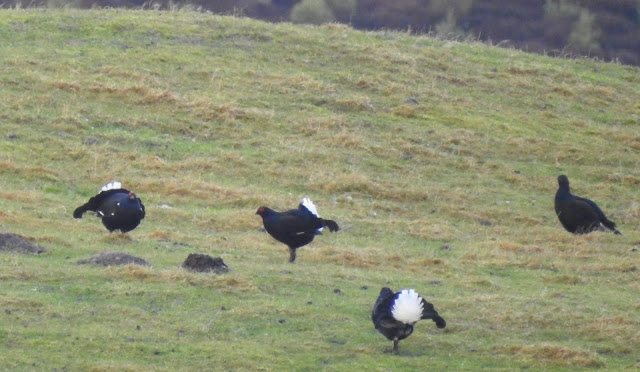 |
| Black Grouse displaying soon after dawn |
Black Grouse are one of my favourite local speciality birds, and always prove popular with my safari clients, especially from January to May when they usually display and lek. However, our dawn (7:30am) visits to their traditional 'lek' sites gave 'patchy' results this month, with a couple of 'no shows' offset by up to 12 cock birds showing beautifully on one occasion...
 |
| Red Grouse |
Our local
Red Grouse were already showing signs of pre-breeding season territorial behaviour early in the month, however, the Arctic blast from mid-month saw many of them switch to a more survival-based tactic of temporarily forming 'mega-flocks' and moving around to slightly less windswept and cold areas....
 |
| Crested Tit |
In the Caledonian pine forests, our local
Crested Tits continued to show well at my favourite forest feeding stations, especially soon after dawn, and particularly on the colder days, when they are presumably at their most desperate for food, with up to 3 of these true 'local specialities' showing at once...
It is well worth noting that the winter months (October-March) are actually the best time of year for seeing the 'wee Cresties', as these characterful little birds can be frustratingly secretive and unobtrusive during the breeding season, with sightings being much more difficult to obtain between April and September....
Still in the Caledonian pine forests.... and despite my best efforts.. sadly,
Crossbill sightings were, as usual, limited to very brief glimpses of birds flying over, with us only being able to identify them by their characteristic 'jip-jip' calls....
Continuing the forest theme, after reasonable success with Capercaillie in October and November, 'normal service' continued , and sadly, despite lots of dawn searching....we did not get lucky with any sightings at all this month...and I still need to see one for my 2019 bird 'year-list'.....
 |
| Dipper |
On the rivers, our local
Dippers continued to entertain, with their rarely-heard rippling warble of a song being projected proudly from a prominent rock soon after dawn as they presumably attempt to proclaim their ownership of the territory, and attract a female...and it still makes me shiver every time I see them submerge themselves in an ice-fringed river when feeding, they sure are hardy little critters...
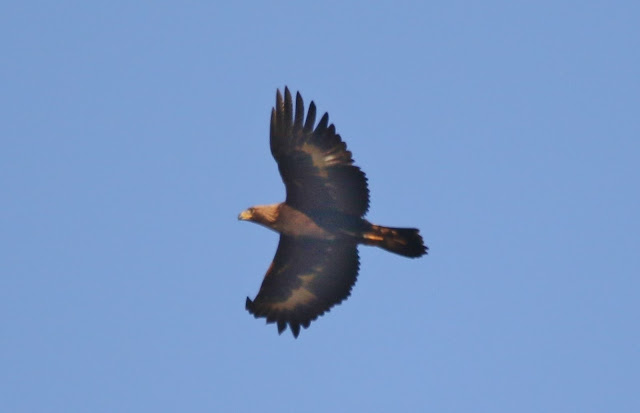 |
Golden Eagle by Steve Nicklin
|
 |
| Sparrowhawk with prey |
January is normally a pretty decent month for sightings of birds of prey in this area, but the wild and wintry weather from mid-month and the consequent lack of enthusiasm from the public for my safaris restricted my visits to the remote local upland glens to a handful of opportunities, though
Golden Eagle,
Red Kite,
Common Buzzard ,
Sparrowhawk and
Kestrel were still all seen....which is pretty decent I reckon...
With the Cairngorm Funicular Railway still out of action for major repairs, the weather being very wintry, and the days so short now, I didn't venture up into the mountain-tops myself this month,preferring to stick to the lower slopes instead, but for future reference, a few Ptarmigan , now totally white, can sometimes be seen, up around the 'snow-line', usually sheltering on the leeward sides of ridges, out of the cold wind.
 |
| Snow Bunting |
 |
| Snow Bunting |
Still on a mountain theme, Snow Buntings were often easier to see this month, driven down to lower altitude sites by the winter snow and colder weather, with flocks of over 20 of these very attractive birds proving to be very obliging in coming to wild bird seed and giving us some decent photo opportunities, though when there is lots of snow and the subsequent snowsports going on, the increased human activity does mean that they can get disturbed quite frequently.....
 |
| Waxwing |
 |
| Waxwings |
Similarly to last month,
with most of our local berries now gone, the Waxwing flocks seem to have moved on to pastures new... with just the odd local sighting of small groups, mostly at urban sites...but, alerted by my Rare Bird Alert pager, I ventured up to Elgin on the morning of the 19th to enjoy great close-up views of a small flock of these beautiful and often very obliging birds..
 |
| Bramblings |
 |
| Drake Goldeneye |
 |
| Hybrid Ross's Goose x Snow Goose by Mark Keighley |
Other good birds seen or reported locally this month included: Whooper Swan, Goldeneye, Brambling, Redpoll, and a probable hybrid Ross's Goose x Snow Goose...
 |
| Midwinter on a local moorland |
Moray coast highlights:
 |
| Bar-Tailed Godwit |
 |
| A raft of Eiders |
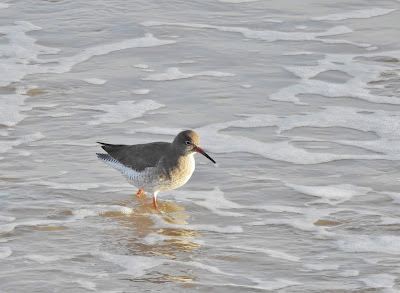 |
| Redshank |
 |
| Long-Tailed Duck |
 |
| Purple Sandpiper |
The Moray coast is only about a one hour drive north of Aviemore, and my trips to favourite reserves, lochs, bays and harbours gave good views of wintering birds such as Greylag Geese, Pink-Footed Geese, Whooper Swan, Shoveler, Gadwall, Wigeon, Teal, Scaup, Pintail, Bar-Tailed Godwit, Knot, Golden Plover, Ringed Plover, Purple Sandpiper, Common Scoter, Velvet Scoter, Goosander, Red-Breasted Merganser,and a few Long-Tailed Ducks....
January 2019 Mammal sightings:
 |
| Mountain Hare |
Mountain Hares 'in their stunning 'winter-white' coats, stole the show' again this month, with these cute looking, but in reality, 'hard as nails' animals most often being voted as 'mammal of the day' by my safari clients. But did you know that the Mountain Hare is Britain's only indigenous 'Lagomorph'? As the others, Brown Hare and Rabbit were both introduced here by man, from other countries...as Michael Caine might say "not a lot of people know that"....
 |
| Red Deer stag |
Still in the uplands, our local Red Deer could be seen happily grazing on the tops of the ridges in the mild weather early in the month, but adapted to the much more wintry second half of the month, by dropping down into less exposed and snow-free areas....
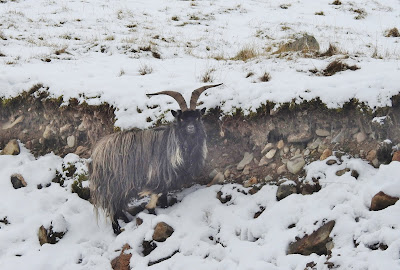 |
| Feral Mountain Goat (pic from Jan 2018) |
Our local feral Mountain Goats were a bit conspicuous by their absence in the upland glens this month, with most of our sightings at very long range, and I suspect they may well have spent much of their time sheltering from the wintry weather in and around the forestry plantations....
 |
| Red Squirrel |
In the Caledonian pine forests, the ever-popular and always cute Red Squirrels could be seen taking advantage of the peanuts on offer at feeding stations, though we did also get plenty of 'random' sightings during our walks and drives through suitable habitat..
 |
| Roe Deer (pic from winter 2015) |
Roe Deer as usual, were mainly seen at dawn or soon after, and generally at the quieter sites well away from human disturbance, their shy nature making them much harder to see than Red Deer, despite being considerably more numerous and widespread than their larger 'cousins'...
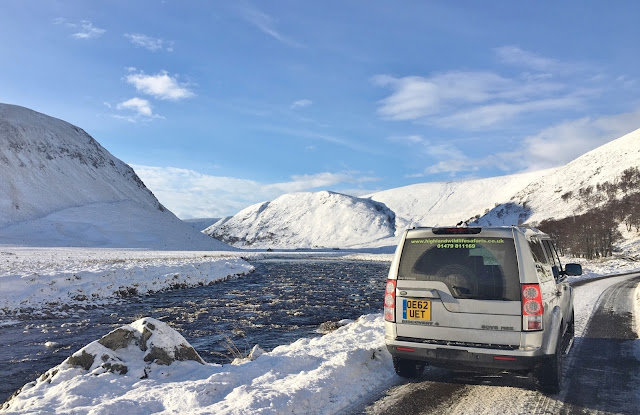 |
| On safari in a picturesque local upland glen |
Well, despite the particularly wintry start to the year making it a bit 'quieter' than normal on the safari bookings front, I reckon we have still got the wildlife-watching year off to a pretty good start... and the days are lengthening, the birds are definitely sensing that spring is approaching, and the bookings diary is filling up, partly due to the 'Winterwatch effect' - the popular BBC show is currently highlighting the marvellous scenery, special habitats and rare wildlife of this area.....
Find out more at: https://www.bbc.co.uk/programmes/p06zdxl1
If you think you know someone who may enjoy a taste of what I do, why not treat them to a safari gift certificate. They make a thoughtful and imaginative present, are available for any amount and are valid at any time within a year from date of purchase....








